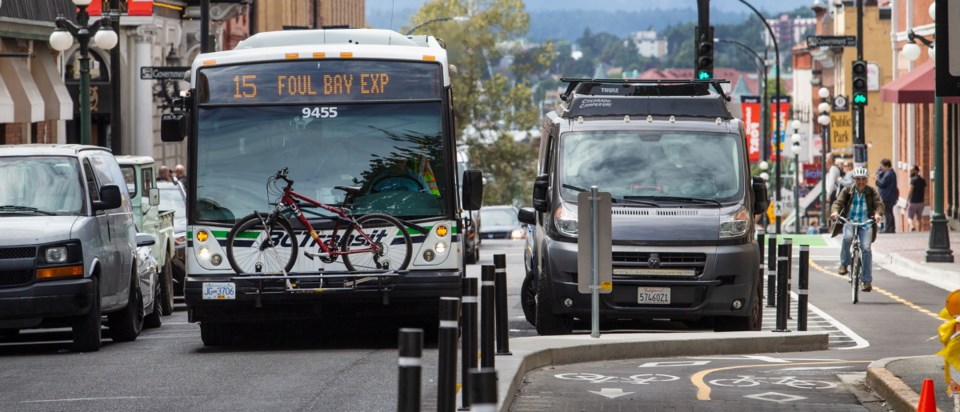The new bike lanes have squeezed Fort Street so tight that an improperly parked car has the potential to stop buses, says transit union president Ben Williams.
“Operators are having huge issues with it,” said Williams, president of Unifor Local 333BC.
“Because of the parking that is there, if they are all parked just right you can just barely make it down.”
The city officially opened the $3.27-million, two-way cycle track, which runs on the north side of Fort between Wharf and Cook streets, last Sunday.
Brad Dellebuur, the City of Victoria’s assistant director of transportation, was surprised at Williams’s comments, saying the city consulted with B.C. Transit in designing the new cycle route and the road lane meets transit guidelines.
“They’ve got a travel lane that’s 3.3 metres wide next to the parking lane that’s 2.5,” Dellebuur said. “There’s nothing on the corridor that’s less than that, so it’s meeting all their guidelines.”
But Williams said if someone parks improperly or too far from the curb, it’s problematic.
“There was a situation where the operator was going down the road and they weren’t sure that they would be able to carry on because it was getting too narrow,” he said. “They said the part that was really concerning was that if they couldn’t carry on, people couldn’t get off the bus either, because they were so jammed up against vehicles.”
Williams said the problem is most acute in the block just east of Wharf Street but there are issues along the whole 1.2-kilometre stretch.
Exacerbating the situation is that some cyclists continue to use the traffic lane on the south side of Fort, he said.
“So if you’ve got cyclists that also are going down the road that buses are having a hard time even navigating down, [the buses] would be stuck behind the cyclist because they wouldn’t be able to pass.”
Dellebuur agreed improperly parked cars can make things tight, and said there is nothing to prohibit cyclists from using the general travel lanes.
“The strong and confident cyclists, some are going to ride in the general purpose lanes, and like everywhere in B.C., they’re allowed to do that,” he said.
While Williams said the union was not consulted on the bike lane’s design, B.C. Transit spokesman Jonathon Dyck said the corporation was and the city did make adjustments based on that consultation.
“We have to work safely within the infrastructure provided, and the City of Victoria makes the final decision about the design for transportation infrastructure within their jurisdiction,” Dyck said in a statement.
Drivers are also frustrated that they can no longer turn left on a red light from Wharf Street onto Fort, Williams said.
“That’s a huge problem for transit vehicles, especially at this time of year with tourists, because Wharf Street is so congested and busy; that is usually when they were able to make the left hand turn — on the red,” he said.
“So operators have said they are now getting stuck sitting there for a long time trying to make that left-hand turn.”
Dellebuur said the change was necessary to accommodate cyclists wanting to turn left from Fort onto Wharf.
“In order for cyclists to get out into Wharf Street, if they turn right it’s no big deal, but if they’re wanting to turn left and go south, you can’t have that conflict with people who stop at the red light on Wharf Street and want to turn left,” he said.
He said the change is temporary and the city will monitor its operation.
Transit drivers raised similar concerns when the $3.4-million Pandora Avenue bike lane opened last year. Williams said Pandora continues to be a problem for drivers.



